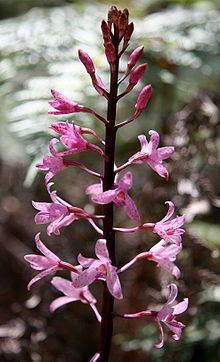Alliance Dipodium Scientific name Dipodium roseum | Family Orchidaceae Tribe Cymbidieae Genus Dipodium Rank Species | |
 | ||
Similar Dipodium, Dipodium punctatum, Dipodium variegatum, Dipodium pardalinum, Cryptostylis subulata | ||
Dipodium roseum orchids in freycinet national park tasmania
Dipodium roseum, commonly known as rosy hyacinth-orchid or pink hyacinth-orchid, is a leafless mycoheterotrophic orchid found in east and south-eastern Australia.
Contents
- Dipodium roseum orchids in freycinet national park tasmania
- Description
- Taxonomy
- Distribution and habitat
- Ecology
- Cultivation
- References
Description
For most of the year, plants are dormant and have no above-ground presence. Below the ground lie fleshy roots. Flower spikes ranging from 30 to 90 cm in height appear between December and April. These racemose inflorescences have 15 to 40 pink flowers with small darker spots. The sepals and petals are strongly recurved and the three-lobed labellum is pink with dark lines and a band of mauve hairs. A rare white-flowering form also exists.
Taxonomy
The species was formally described in 1991. The type specimen was collected in Montrose in Victoria's Dandenong Ranges. The species was previously included in a wider circumscription of Dipodium punctatum.
Distribution and habitat
Dipodium roseum occurs in dry woodland in the states of Queensland, New South Wales, Victoria, South Australia, Australian Capital Territory and Tasmania.
Ecology
Pollination of this species, as for all species in the genus, is by native bees and wasps.
Cultivation
No leafless species of Dipodium has been sustained in cultivation due to the inability to replicate its association with mycorrhizal fungi in a horticultural context.
